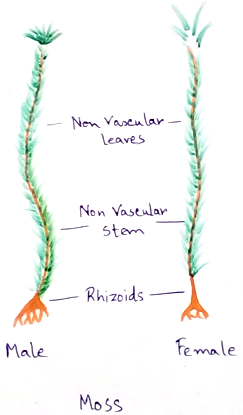Mosses
Characteristics features of mosses are:
1. These types of Bryophyte are foliose with radial symmetry.
2. Having multicellular rhizoid.
3. Contains protonema stage (the precursor of the leafy gametophores of certain mosses and liverworts developed as a product of spore germination in a form of a filamentous or thalloid mass) in life cycle.
4. Sex organs generally occur in cluster at the tip of stem branches.
5. Sporophyte or sporangium has assimilatory tissue, a central columella and peristome (in most mosses a ring of tooth like cellular or acellular structure is developed at the mouth of capsule).
6. Leaves and stems of mosses are not homologous to those of vascular plants because of being gametophyte.
7. Most of the mosses have upright stems with conducting tissue hadromes and leptom both in gametophytes and sporophytes.
8. Stomata present on the epidermis of sporophyte but with single doughnut shaped guard cell.
9. Most of them contain operculum and annulus.
10. Sporophyte in most emerging early from calyptras, maturing after its rupture.
11. Sporogenesis occurs simultaneously.
Some of the mosses are as follows:
Funaria/Moss – male and female sex organs are born on different branches of the same plant, this condition is known as autoicous condition.
Polytrichum - it is also called hair cap moss. It shows distinct vascular system for carrying water whereas other moss they are lack of this system.
Sphagnum - the whole sporophyte is raised by an elongated gametophytic stalk called pseudopodium. A pressure of about 3 atm is generated in the lower half of the capsule as it dries. The pressure dislodges the lid or operculum with an explosive force and spores are effectively dispersed.
Different uses of sphagnum:
- Used as diaper material as it can hold water 20 times of it weight when saturated.
- Used in dressing of wounds and boils during war.
- In horticulture as packing material it is used as a planting medium and as a soil additive.
- Act as source of peat which is used as fuel.
Questions and answers on Mosses:
1. Which Moss is called granite moss?
Some species of Andreae are known as granite mosses. The plants are known to occur in cold mountainous regions of Arctic, often on granite rocks.
2. What is moss ball?
Grimmia longirostrisa moss of Andean Paramo which grows on thin soil of rocks, become disrupted by frost. These disrupted soils chunks with the moss results in spheroid mass of soil and are called moss balls.These moss balls are freely distributed by wind. And since the moss has the unique capacity of regeneration from any part of the body,promptly in develop into new plant in suitable environment.
3. Which moss is called bogmoss and why?
Sphagnum is called bogmoss. Phenolic substances present in the dead cells extract metallic cations from in flowering waters and release hydrogen ions. This makes the acidity values around pH 4.0 or even less. The lack of oxygen in the lower levels of the bog hinders the oxidation of dead organic matter, leading to accumulation of peat.
Recent Articles
-
Explain about Growth in Plants |Definition of Growth & Differentiation
Feb 27, 25 02:07 PM
Growth is a permanent increase in length or volume of an organism that brought upon by an increase in its dimensions due to synthesis of new protoplasmic material. -
Definition of Respiratory Quotient | calculation | Application | Plant
Dec 02, 24 12:09 AM
Definition of respiration quotient- the ratio of the carbon-dioxide evolved to that of the oxygen consumed by a cell, tissue, plants or animals in a given time is called respiratory quotient. It is us… -
Amphibolic Pathway | Definition | Examples | Pentose Phosphate Pathway
Jun 06, 24 10:40 AM
Definition of amphibolic pathway- Amphibolic pathway is a biochemical pathway where anabolism and catabolism are both combined together. Examples of amphibolic pathway- there are different biochemical… -
Respiratory Balance Sheet | TCA Cycle | ATP Consumption Process
Feb 18, 24 01:56 PM
The major component that produced during the photosynthesis is Glucose which is further metabolised by the different metabolic pathways like glycolysis, Krebs cycle, TCA cycle and produces energy whic… -
Electron Transport System and Oxidative Phosphorylation | ETC |Diagram
Feb 04, 24 01:57 PM
It is also called ETC. Electron transfer means the process where one electron relocates from one atom to the other atom. Definition of electron transport chain - The biological process where a chains…





New! Comments
Have your say about what you just read! Leave me a comment in the box below.